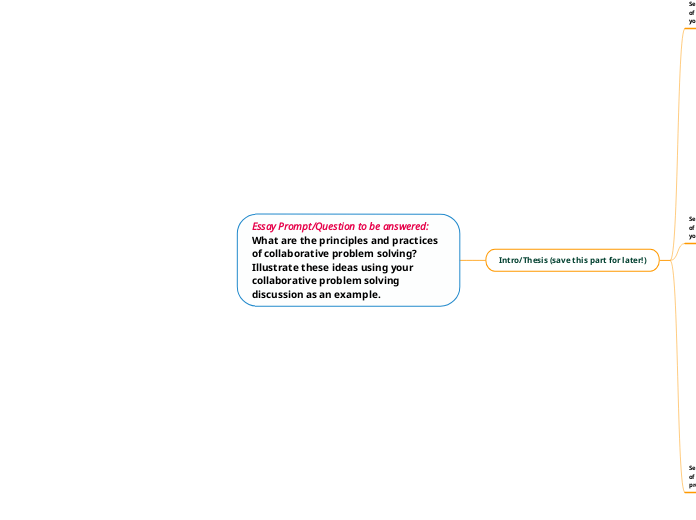Essay Prompt/Question to be answered: What are the principles and practices of collaborative problem solving? Illustrate these ideas using your collaborative problem solving discussion as an example.
Intro/Thesis (save this part for later!)
Section 1 Question: What are the principles and practices of connecting to the humanity of the other? Connect to your problem solving session.
Main Point: The first step in collaborative problem solving is to connect to the humanity of the other.
What are the relevant principles?
Adversarial approach is when it is a win or lose situation, one will win while the other will lose no matter what.
Collaborative approach is when they are both trying to get a win win out of the situation so they both get what they want. It’s a win win for both of them.
What makes a conflict transformed is when we are connecting to the humanity of the other person. Connecting to the humanity of the other person means you stop and think of the feelings, values and thoughts of the other person and be willing to recognize them.
Compassion is our feeling for the care of struggling for the other person.
The relationship between compassion and curiosity is being able to be open to understanding the other person and their needs.
To take a credulous approach means you are able to understand what they are saying makes sense to them even if it doesn’t make sense to you or you don’t agree with them you still have to understand it makes sense to them.
Having courage is important because it gives you the advantage to resist attack, admit that you may be wrong, act with care and being able to assist your needs.
How do you put these ideas into practice?
You can’t solve any problems while you are angry you have to make sure you are both calmed down and that no one is angry so you can try and fix the problem.
Section 2 Question: What are the principles and practices of understanding the needs of each person?Connect to your problem solving session.
Main Point: After connecting to the humanity of the other, we can begin the process by understanding each persons needs or interests.
What are the relevant principles?
The persons position in a dispute is typically a solution to a problem that is never stated.
A position is one’s initial side or stance, an initial solution to an unstated problem
A need is one’s interests, wants, and desires, the problem one is trying to solve.
The important connection between needs and positions is that the position is the surface level and the more you talk to them the more you want to get to the needs which is what’s actually the problem is.
How do you put these ideas into practice?
The two modes for collaborative problem solving are empathic listening and self assertion.
Characteristics of empathic listening are don’t interrupt, listen and summarize, ask questions about your partners needs, allow your partner to correct you and express empathy for your partners issue/situation.
Characteristics of self assertion are using I statements to express needs, interests and feelings not positions and also describe concrete events and don’t characterize them.
The importance of I statements are that we parse away our judgements of the other person from the unmet needs and feelings that arise within us in any situation involving conflict.
Section 3 Question: What are the principles and practices of brainstorming possible solutions?Connect to your problem solving session.
Main Point: Once each person's needs have been discussed and acknowledged, the next step is to brainstorm possible solutions to the problem that will satisfy both parties.
What are the relevant principles?
The aim of the brainstorming stage is to brainstorm ideas in order to resolve the problem/conflict. Also to show the pros and cons of each solution.
It differs from the other stage because this stage is brainstorming possible solutions while the previous stage was the hardest one to get past which was stating each others needs and being able to listen to their needs and wants.
You will have to create a common ground because in most cases it isn’t found you have to create it.
How do you put these ideas into practice?
Once everyone’s needs are identified, in the brainstorming stage you can’t start to brainstorm ways to resolve the situation even if they aren’t reasonable it is still worth brining up.
It’s important to remember not to limit yourself and to avoid judging whether the solutions you generate are good or bad.
The best way in order to evaluate a solution is to have each person state each need with the pros and cons of each possible solution and keep working on one until you mutually agree to a solution.
